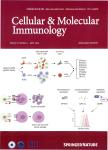Hepatitis C virus core protein triggers expansion and activation of CD4+CD25+ regulatory T cells in chronic hepatitis C patients
Hepatitis C virus core protein triggers expansion and activation of CD4+CD25+ regulatory T cells in chronic hepatitis C patients作者机构:Institute of Translational Medicine The First Hospital Jilin University Changchun China Department of Hepatology The First Hospital Jilin University Changchun China Institute Pasteur of Shanghai Chinese Academy of Sciences Shanghai China Department of Pathology University of Washington Seattle WA USA Lineberger Comprehensive Cancer Center School of Medicine University of North Carolina at Chapel Hill Chapel Hill NC USA
出 版 物:《Cellular & Molecular Immunology》 (中国免疫学杂志(英文版))
年 卷 期:2015年第12卷第6期
页 面:743-749页
核心收录:
学科分类:0710[理学-生物学] 1004[医学-公共卫生与预防医学(可授医学、理学学位)] 1002[医学-临床医学] 1001[医学-基础医学(可授医学、理学学位)] 07[理学] 08[工学] 09[农学] 071009[理学-细胞生物学] 071007[理学-遗传学] 0901[农学-作物学] 0836[工学-生物工程] 090102[农学-作物遗传育种]
基 金:This work was supported by the Natural Science Foundation of China (81373143 to ZT) and by NIH (AI095097 to LS). The funders had no role in the study design data collection and analysis decision to publish or preparation of the paper
主 题:CD4+CD25+ regulatory T cells HCV core Toll-like receptor
摘 要:CD4+CD25+FoxP3 + regulatory T ceils (Tregs) are increased in patients with chronic hepatitis C, which may contribute to the sustained suppression of hepatitis C virus (HCV)-specific T-cell responses and viral persistence in HCV-infected individuals. We postulated that HCV core protein (HCVc) directly contributes to the expansion of Tregs in HCV-infected patients, and we provide evidence to support this hypothesis in the report. Peripheral blood mononuclear cells (PBMCs) and sera were collected from 87 treatment-naive chronic HCV-infected patients, CD4+CD25+ Tregs were measured by flow cytometry, and HCV RNA and HCVc levels were detected using qPCR and enzyme-linked immunosorbent assay (ELISA), respectively. CD4+, CD8+, CD4+CD25+ and CD4+CD25- T cells were purified from healthy donors and cultured with recombinant HCVc and Toll-like receptor (TLR) ligands. Flow cytometry was used to analyze cell proliferation, and ELISA was performed to measure cytokine production. In the 87 chronic HCV-infected patients, HCVc showed a significant correlation with HCV RNA and CD4+CD25+Tregs. Mechanistic studies showed that HCVc, together with anti-CD3 antibody, augmented CD4+CD25+ Treg proliferation, but inhibited CD4+CD25- T-cell proliferation and IFN-γ production, in a dose-dependent and Treg-dependent manner. Moreover, unlike the TLR3 ligand (poly hC) and the TLR4 ligand (lipopolysaccharide, LPS), the TLR2 ligand (lipoteichoic acid, LTA) and HCVc both inhibited TCR-induced CD4+ T-cell proliferation and IFN-γ secretion in a Treg-dependent manner. These data indicate that HCVc, like other TLR2 ligands, triggers CD4+CD25+ Treg activation and expansion to inhibit host immune responses, which may play a critical role in viral persistence in HCV-infected patients.



